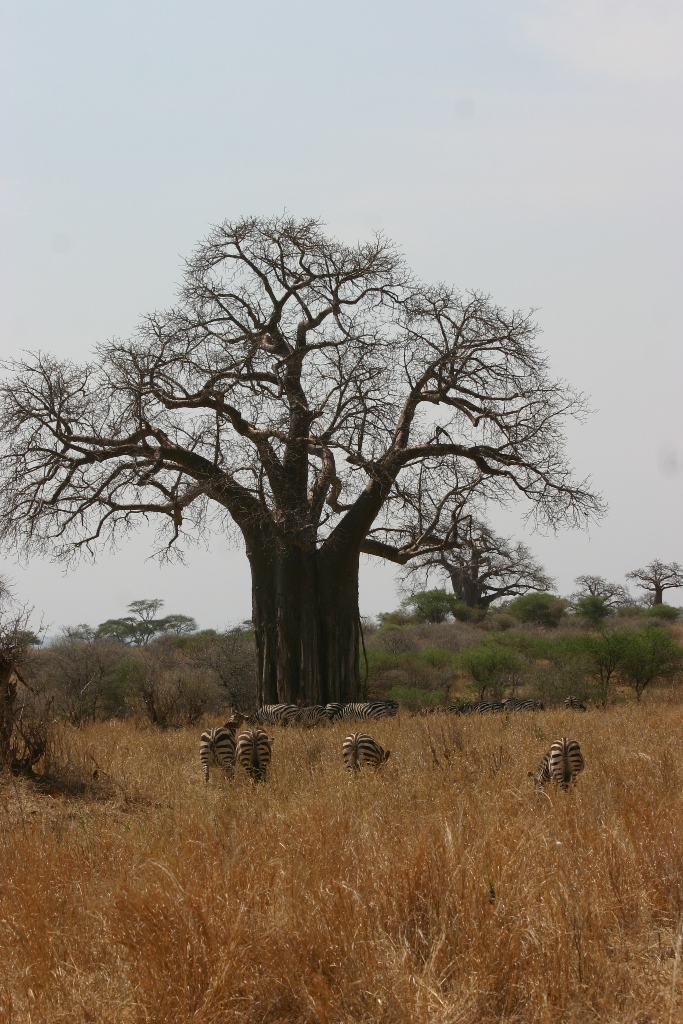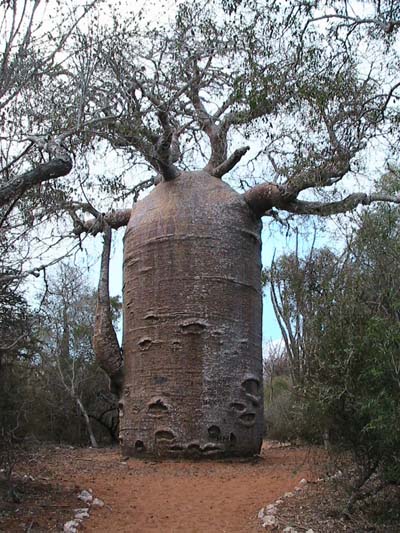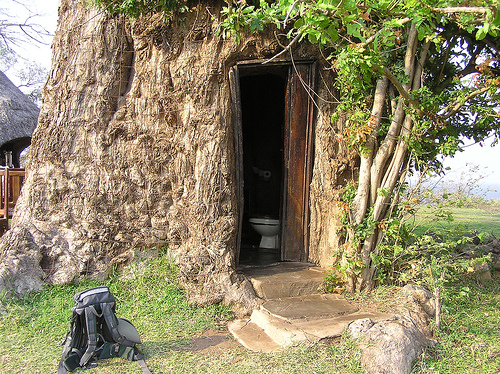ONLINE VACATION
BAOBAB TREES IN AFRICA
10/09/13
Hi Everyone. Today, we are going to the continent of Africa to see baobab trees.
They are unique and only found a couple places in the world.
Here is what I found out about these unique trees.
The African Baobab Tree (Adansonia digitata) is a tree with many
stories and interesting facts.
The baobab tree can be found all over the African continent and even
Madagascar. It reaches heights of 16 to 98 feet and has a trunk diameters
of 23 to 36 feet. Flowers are large being up to 7 inches in size. The
tree produces edible fruit, called monkey bread as especially baboons
love it. The fruit has a sour taste. In the African culture the
fruit, seeds and even young leaves and seedlings are used for local
dishes and drinks.
The African tribes call the tree "the upside down tree". When bare of
leaves, the spreading branches of the Baobab look like roots sticking
up into the air as if it had been planted upside-down. An African
legend tells that the baobab was amongst the first trees to appear on
Earth. When the palm tree, the flame tree and the fig tree appeared,
the Baobab began to grumble that it wanted to be taller, to have
brilliant flame colored flowers, and bear tasty fruit too. The Gods
grew angry at this incessant wailing and pulled up the tree by its
roots, and replanted in upside down to keep it quiet!
The African baobab tree is also called the "tree of life" as it can store
water during the drought season which is sometimes vital to the rural
population. Large baobab trees could contain more than 30,000 gallons
of water, and to get to it, Kalahari bushmen use hollow pieces of
grass like a straw to suck the water out.
The baobab is Africa's latest fair trade sensation. On July 15, 2008 the
European Union has officially approved the export of powdered baobab
fruit to the United Kingdom as a healthy additive to cereal bars and
smoothies. The baobab is said to have three times the vitamin C
content of an orange, and as much calcium as a glass of milk.
According to Britain's University of Southampton, the baobab is rich
in vitamin B1, B2, and C, and calcium, plus it's bursting with antioxidants.
Natural medicine uses the bark of the Baobab to lower fevers, chewing a
leaf will wake you up and ingesting some of the tartar powder will
help with stomach aches.
The citric and tartaric acids found in the pulp provide the base for cream
of tartar, often used as a baking ingredient.
Because of their size, people have been storing supplies in old hollow
trunks or have been living inside a Baobab Tree. In rural Africa the
bark is used to make ropes and even clothing.
I hope you have enjoyed this trip to the continent of Africa to see and
learn about the Baobab tree.
~Marsha~












AND THE BEST ONE... IMAGINE THIS...

They are unique and only found a couple places in the world.
Here is what I found out about these unique trees.
The African Baobab Tree (Adansonia digitata) is a tree with many
stories and interesting facts.
The baobab tree can be found all over the African continent and even
Madagascar. It reaches heights of 16 to 98 feet and has a trunk diameters
of 23 to 36 feet. Flowers are large being up to 7 inches in size. The
tree produces edible fruit, called monkey bread as especially baboons
love it. The fruit has a sour taste. In the African culture the
fruit, seeds and even young leaves and seedlings are used for local
dishes and drinks.
The African tribes call the tree "the upside down tree". When bare of
leaves, the spreading branches of the Baobab look like roots sticking
up into the air as if it had been planted upside-down. An African
legend tells that the baobab was amongst the first trees to appear on
Earth. When the palm tree, the flame tree and the fig tree appeared,
the Baobab began to grumble that it wanted to be taller, to have
brilliant flame colored flowers, and bear tasty fruit too. The Gods
grew angry at this incessant wailing and pulled up the tree by its
roots, and replanted in upside down to keep it quiet!
The African baobab tree is also called the "tree of life" as it can store
water during the drought season which is sometimes vital to the rural
population. Large baobab trees could contain more than 30,000 gallons
of water, and to get to it, Kalahari bushmen use hollow pieces of
grass like a straw to suck the water out.
The baobab is Africa's latest fair trade sensation. On July 15, 2008 the
European Union has officially approved the export of powdered baobab
fruit to the United Kingdom as a healthy additive to cereal bars and
smoothies. The baobab is said to have three times the vitamin C
content of an orange, and as much calcium as a glass of milk.
According to Britain's University of Southampton, the baobab is rich
in vitamin B1, B2, and C, and calcium, plus it's bursting with antioxidants.
Natural medicine uses the bark of the Baobab to lower fevers, chewing a
leaf will wake you up and ingesting some of the tartar powder will
help with stomach aches.
The citric and tartaric acids found in the pulp provide the base for cream
of tartar, often used as a baking ingredient.
Because of their size, people have been storing supplies in old hollow
trunks or have been living inside a Baobab Tree. In rural Africa the
bark is used to make ropes and even clothing.
I hope you have enjoyed this trip to the continent of Africa to see and
learn about the Baobab tree.
~Marsha~










AND THE BEST ONE... IMAGINE THIS...

Information from Silke Ceruti
http://ezinearticles.com
This is a MelloMarsha creation
I do not take credit for the pictures
Thanks to the respective photographers
10-09-13
BACK TO THE ONLINE VACATION INDEX